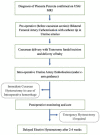Placenta percreta - a management dilemma: an institutional experience and review of the literature
- PMID: 33274037
- PMCID: PMC7726456
- DOI: 10.4274/jtgga.galenos.2020.2020.0106
Placenta percreta - a management dilemma: an institutional experience and review of the literature
Abstract
Objective: Placenta percreta is an extremely high-risk obstetric condition often associated with significant maternal morbidity and mortality. To date, there is no consensus on its management. This article aimed to identify an optimum management option to improve maternal outcomes in patients with placenta percreta.
Material and methods: This was an observational study conducted at a tertiary care institute from October 2019 to June 2020. A well-defined plan of preoperative, bilateral, uterine artery catheter placement, cesarean delivery (CD) of the baby followed by uterine artery embolization (UAE), and elective delayed hysterectomy after 2-4 weeks, was made by a multidisciplinary team. Demographic variables such as age, parity, period of gestation, presenting complaints, imaging findings, mode of management, intraoperative findings, blood loss, the requirement for blood and blood products, and complications were noted.
Results: We encountered seven cases of placenta percreta over a period of nine months. UAE was performed in 6/7 patients. UAE was not performed in one patient as she presented to the emergency department in shock. Elective delayed hysterectomy was performed after 2-4 weeks in three patients, three patients required emergency hysterectomy (two during CD and one on the seventh postoperative day) and one patient was managed conservatively by leaving the placenta in situ after CD and UAE. Patients who underwent UAE had notably less intraoperative blood loss and requirement of blood and blood products than the patient who could not receive UAE. During cesarean hysterectomy, blood loss was 1,700 mL in embolized (case 4) vs 3,000 mL in unembolized patient (case 7). In embolized patients, the median blood loss during CD (case 1,2,3,5,6) was 200 mL (interquartile range: 165-200 mL) and during delayed elective hysterectomy (case 1,3,5) was 150 mL (range: 125-225 mL). Blood loss in case 2 was 1,000 mL during emergency hysterectomy on the 7th day of CD and UAE. The blood loss was appreciably higher in patients who underwent immediate cesarean hysterectomy rather than elective delayed hysterectomy.
Conclusion: Placenta percreta, if not managed in a preplanned manner, may lead to disastrous maternal outcomes. Prophylactic devascularization during CD and leaving the placenta in situ followed by elective delayed hysterectomy, might be a reasonable management option in most severe cases of placenta percreta.
Keywords: Placenta percreta; elective delayed hysterectomy; immediate cesarean hysterectomy; uterine artery embolization.
Conflict of interest statement
Figures





Similar articles
-
Placental uterine artery embolization followed by delayed hysterectomy for placenta percreta: A case series.Gynecol Oncol Rep. 2021 Jul 16;37:100833. doi: 10.1016/j.gore.2021.100833. eCollection 2021 Aug. Gynecol Oncol Rep. 2021. PMID: 34368412 Free PMC article.
-
Placenta percreta is associated with more frequent severe maternal morbidity than placenta accreta.Am J Obstet Gynecol. 2018 Aug;219(2):193.e1-193.e9. doi: 10.1016/j.ajog.2018.04.049. Epub 2018 May 5. Am J Obstet Gynecol. 2018. PMID: 29733839
-
Prophylactic intraoperative uterine artery embolization to control hemorrhage in abnormal placentation during late gestation.Fertil Steril. 2009 May;91(5):1951-5. doi: 10.1016/j.fertnstert.2008.02.170. Epub 2008 May 23. Fertil Steril. 2009. PMID: 18501901
-
Management of placenta percreta: a review of published cases.Acta Obstet Gynecol Scand. 2014 Feb;93(2):138-43. doi: 10.1111/aogs.12295. Epub 2013 Nov 25. Acta Obstet Gynecol Scand. 2014. PMID: 24266548 Review.
-
Successful anticoagulant therapy for disseminated intravascular coagulation during conservative management of placenta percreta: a case report and literature review.BMC Pregnancy Childbirth. 2017 Dec 29;17(1):443. doi: 10.1186/s12884-017-1634-8. BMC Pregnancy Childbirth. 2017. PMID: 29284430 Free PMC article. Review.
Cited by
-
Management and outcomes of women with placenta accreta spectrum grade 3: an INOSS multicountry multiperiod population-based study.BMC Pregnancy Childbirth. 2025 Apr 7;25(1):401. doi: 10.1186/s12884-025-07271-2. BMC Pregnancy Childbirth. 2025. PMID: 40197338 Free PMC article.
-
A Review of Conservative Surgical Approaches for Managing Placenta Accreta Spectrum.Cureus. 2025 Mar 31;17(3):e81551. doi: 10.7759/cureus.81551. eCollection 2025 Mar. Cureus. 2025. PMID: 40314053 Free PMC article. Review.
-
The efficacy of uterine artery embolization for postpartum hemorrhage with placenta accreta spectrum disorder: clinical outcomes in a cohord of 112 pregnant women.Eur Radiol. 2025 Jun 13. doi: 10.1007/s00330-025-11744-5. Online ahead of print. Eur Radiol. 2025. PMID: 40512219
-
Haematuria from early pregnancy in a morbidly adherent placenta: Case report and a short review.J Family Med Prim Care. 2022 Jun;11(6):3276-3279. doi: 10.4103/jfmpc.jfmpc_1204_21. Epub 2022 Jun 30. J Family Med Prim Care. 2022. PMID: 36119171 Free PMC article.
References
-
- Morlando M, Sarno L, Napolitano R, Capone A, Tessitore G, Maruotti GM, et al. Placenta accreta: incidence and risk factors in an area with a particu-larly high rate of cesarean section. Acta Obstet Gynecol Scand. 2013;92:457–60. - PubMed
-
- Miller DA, Chollet JA, Goodwin TM. Clinical risk factors for placenta previa-placenta accreta. Am J Obstet Gynecol. 1997;177:210–4. - PubMed
-
- No authors listed. Royal College of Obstetricians and Gynecologists. Placenta Praevia and Placenta Accreta: Diagnosis and Management (Green-top Guideline No. 27a) London: RCOG. 2018.
-
- Jauniaux E, Alfirevic Z, Bhide AG, Belfort MA, Burton GJ, Collins SL, et al. Placenta Praevia and Placenta Accreta: Diagnosis and Management: Green-top Guideline No. 27a. BJOG. 2019;126:e1–e48. - PubMed
-
- Cahill AG, Beigi R, Heine RP, Silver RM, Wax JR. Placenta accreta spectrum. Am J Obstet Gynecol. 2018;219:B2–16. - PubMed
LinkOut - more resources
Full Text Sources
